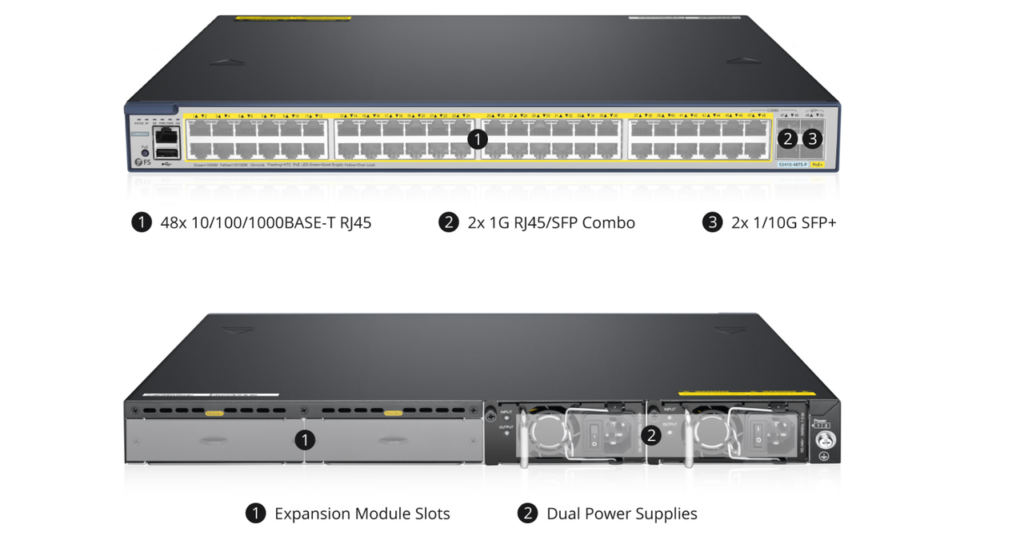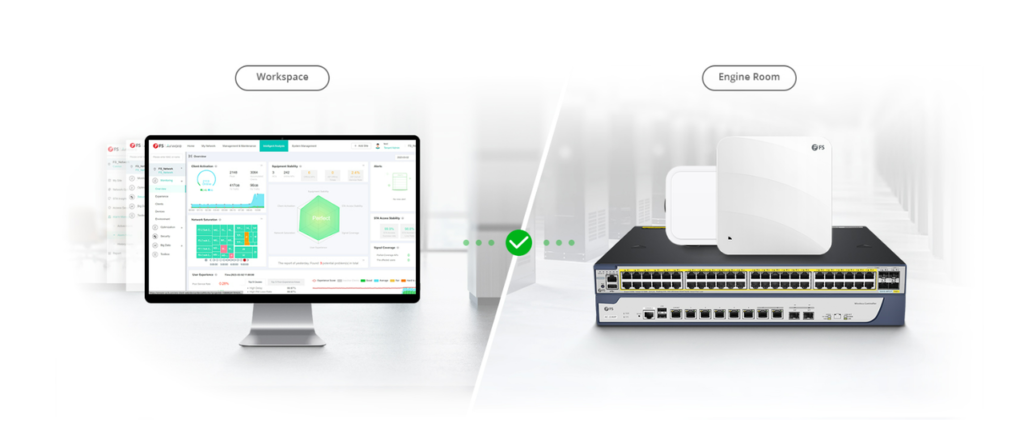Whether in a small office, a large enterprise, or a data center, PoE switches are essential. FS has a range of PoE series switches designed to meet various network needs. This section will compare the S3410-48TS-P switch to other FS PoE switches and provide an in-depth look at the various options available in the FS PoE series switches.
Comprehensive Introduction to FS S3410-48TS-P Switch
The FS S3410-48TS-P switch is a versatile networking device featuring 48×10/100/1000BASE-T ports, 2x1Gb RJ45/SFP combo ports, and 2×1/10Gb SFP+ uplinks. Notably, its Ethernet ports are compliant with IEEE 802.3af PoE and IEEE 802.3at PoE+, delivering the capability to power various standards-compliant PoE and PoE+ end network devices, including IP phones and wireless access points. With a formidable 176 Gbps switching capacity and a forwarding rate of 132 Mpps, this managed enterprise switch ensures robust and efficient network performance.
As for the hardware, the switch is fortified with dual redundant hot-swappable power supplies and dual smart fans, guaranteeing exceptional processing prowess and network reliability. Furthermore, when integrated with the FS Airware Cloud management platform, it augments security and facilitates simplified user and Internet of Things access. Primarily employed at the access layer, this switch serves as a compact and cost-effective solution tailored for deployment in campus, SMB, and enterprise networks.
Comparison of FS S3410-48TS-P Switch and Other Switches
The FS PoE series switches are designed to cater to the diverse requirements of various network architectures. These switches are available in a broad spectrum of configurations, spanning from 8 to 48 ports, accommodating both Ethernet and fiber optic ports. They exhibit robust performance parameters, supporting features such as MLAG, Stacking, QoS, SSH, and more, ensuring the establishment of high-performance networks. In comparison, what distinguishes the S3410-48TS-P switches? The subsequent section outlines some comparative features.
Performance
Comparing the existing three well-selling switches S3150-8T2FP, S3400-24T4FP, and S3410-48TS-P, they have different performance parameters, and the main difference is the port.
The FS S3150-8T2FP operates as a layer 2 switch featuring 8 PoE ports and 2x1G uplink optical ports. Leveraging high-performance hardware and the FSOS platform, it boasts support for essential functionalities such as ACL, QinQ, and QoS. Additionally, it incorporates the ERPS protocol, enabling failover protection with a swift transition time of 50 milliseconds.
Similarly categorized as a Layer 2 PoE switch, the S3400-24T4FP extends its capabilities with 24 ports and a maximum power output of 370W. Its uplink port utilizes a Combo port configuration, housing four 1G Pluggable (SFP) ports. Mirroring the feature set of the S3150 switch, it supports ACL, QinQ, QoS, and ERPS.
Diverging from the aforementioned switches, the S3410-48TS-P switch distinguishes itself with an augmented PoE port count, accommodating a greater number of terminal devices. Notably, it achieves a PoE power delivery of 740W, incorporating two 10G SFP uplink ports and two Combo SFP Ports. Facilitating deployment efficiency, this switch supports stacking and can be seamlessly integrated with a cloud management network platform, offering remote online optimization, configuration, and debugging capabilities.
Appearance Design
From the overall design point of view, the FS S3410-48TS-P PoE switch incorporates a 1+1 hot-swappable power supply configuration and is equipped with two integrated intelligent fans, thereby ensuring the steadfastness of equipment operation. The S3400-24T4FP switch features a built-in power supply and three fans, markedly augmenting its thermal dissipation capabilities. As for the S3150-8T2FP switch, it adopts a fanless design, making it well-suited for office environments where noise reduction is imperative.
Application Scenarios
Switches with these ports are common types of switches in networks, and they are suitable for network environments of different sizes and needs. An exemplar of an 8-port switch, such as the S3150-8T2FP, proves optimal for smaller network setups, including small offices or home networks, connecting a limited number of devices. Primarily designed for personal use, these switches facilitate the interconnection of personal computers, printers, network storage, and other related devices.
The S3400-24T4FP switch is well-suited for the networking demands of small and medium-sized enterprise office environments, accommodating the connection of numerous devices. In scenarios like schools, universities, or other educational institutions, this switch is adept at meeting the network requirements of classrooms, laboratories, and office spaces.
The S3410-48TS-P 48-port switch is fitting for deployment in the core network or data center. It possesses the capability to support a substantial number of devices while upholding high-performance standards. In expansive data center setups, 48-port switches offer ample port capacity to address the connectivity needs of servers, storage devices, and other mission-critical equipment.
| Switch | S3150-8T2FP | S3400-24T4FP | S3410-48TS-P |
| RJ45 Ports | 8x 100/1000BASE-T | 24x 100/1000BASE-T | 48x 100/1000M |
| Fiber Ports | 2x 1G SFP | 4x 1G SFP (4 Combo) | 2x 1G SFP(2 Combo)2x 10G SFP+ |
| PoE Ports | 8x PoE+ | 24x PoE+ | 48 PoE/24 PoE+ |
| PoE Budget | 130W | 370W | 740W |
| Management Layer | L2+ | L2+ | L2+ |
| Stacking | / | / | Up to 4 Units |
| Power Supply | 1 Built-in | 1 Built-in | 1+1 Redundant Hot-swappable |
| Fan | Fanless | 3 Built-in Fans | 2 Built-in Smart Fans |
| QoS, IGMP Snooping, Link Aggregation, IPv6, L3 Static Routing, RIP, OSPF | Yes | Yes | Yes |
Conclusion
In general, the selection of switch ports should be contingent upon the scale of one’s network, the quantity of connected devices, and the requisite bandwidth. Smaller networks commonly find utility in 8-port or 24-port switches, whereas larger or densely populated networks may necessitate a 48-port switch. Furthermore, considerations such as switch performance, management functionalities, and reliability must be taken into account.
Related Articles:







